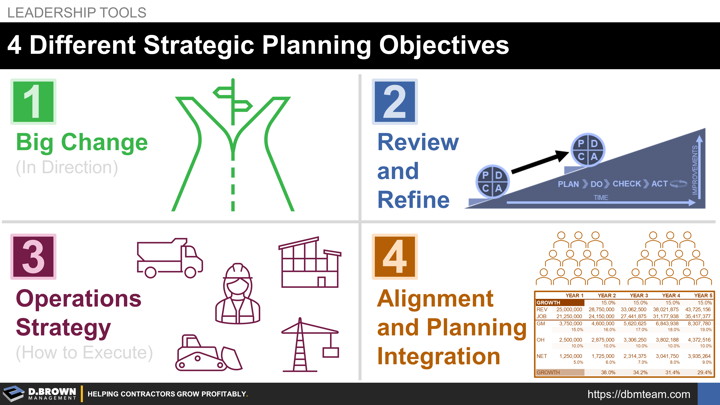There are four broad categories of objectives we see contractors needing to accomplish when we hear the more generic term of "Strategic Planning."
By better defining the objectives, we can help determine:
- Who should be involved, and at what part of the process inside the organization?
- Would there be any benefit in people outside the organization? If so, who, and for what part of the process? This sometimes includes key customers, suppliers, or referral partners. It can include subject matter experts to help evaluate new or changing markets. It can simply be experienced but unbiased 3rd party facilitators.
- What information and preparation work are required for the people who will be involved?
- Who has decision rights, for what, and by when during the process?
- What facilitation methods and tools would be best including the questions to ask around strategy (general), strategy at different levels, and continuous improvement. Good Questions are the core of the process.
The Four Broad Categories:
- Big Change:
- Entering a new market sector, scope of work, project type, or geography
- Exiting or making major adjustments to a changing market
- Changing or adding to the growth strategy in a major way such as via acquisition, merger, joint venture, or other form of strategic partnership.
- Review and Refine: Big changes to strategy should be relatively rare. Many times you are just taking a hard look at historical trends and forecasts to see if you are still on-track to achieve your High-Level Strategic Targets and make Continuous Improvements. This may include defining and launching Strategic Experiments to test out new markets that have the potential to grow to major markets.
- Operations Strategy: If the Strategic Decisions around major markets have been made, sometimes the strategy questions need to revolve around how to operationally support them, including the:
- Project Value Stream (PVS)
- Critical Supporting Operations (CSO)
- Talent Value Stream (TVS)
- The "Guts" of the Contractor Business Model
- Alignment and Planning: The last piece comes down to developing Business Plans over the next three years and Operational Plans over the next 12 months and then aligning a much broader team around those.
There are a lot of nuances in these four categories, but this is a general outline of where we start.

